Inside COP 28
The window to cap global warming at 1.5°C is rapidly narrowing, with the devastating impacts of record-breaking temperatures and extreme weather events intensifying daily.
This year’s UN Climate Change Conference (COP 28) in Dubai was a pivotal moment for strategic decisions and meaningful outcomes to avoid the catastrophic consequences of climate change.
Taking place from November 30 to December 12, this COP saw the conclusion of the inaugural global stocktake under the Paris Agreement, capping a 2-year process with intensive technical work, expert submissions, and more. This was a critical opportunity to assess progress across the globe in achieving the Paris Agreement's objectives on mitigation, adaptation, and means of implementation and support.
The global stocktake was one of the headline items of this year's COP. But it was far from the only item on the agenda—all eyes were also on the highly anticipated Global Goal on Adaptation, as well as how negotiators addressed the need to phase out fossil fuels, among other issues in the COP 28 outcome documents.
IISD's Earth Negotiations Bulletin Reporting On-Site
For over 30 years, Earth Negotiations Bulletin has provided authoritative, in-depth reporting on United Nations negotiations involving the environment and development. Our reporters covered each day of the talks in Dubai, explaining what happened and what it meant for climate action.
Read MoreHighlights from December 13, 2023
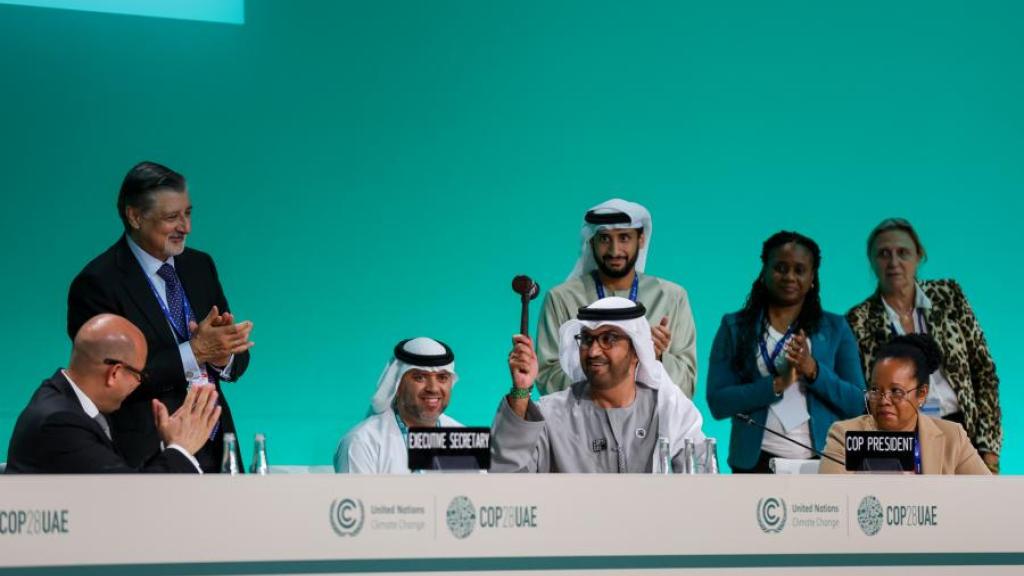
Sultan Al Jaber, COP 28 President and Minister of Industry and Advanced Technology, UAE, declared COP 28 adjourned at 5:11 pm
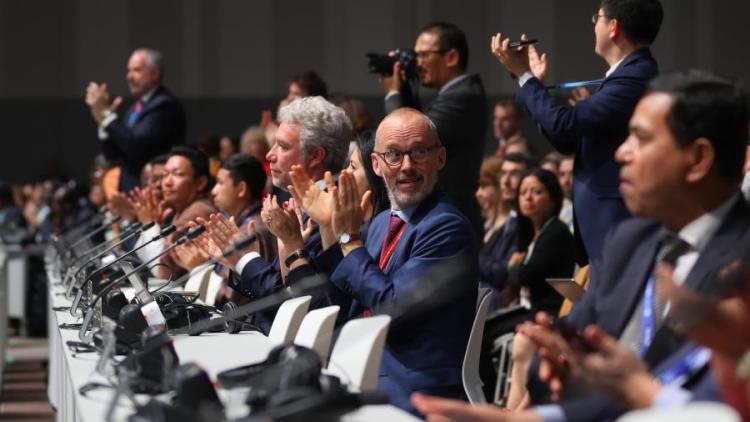
Delegates celebrating the adoption of the Global Stocktake
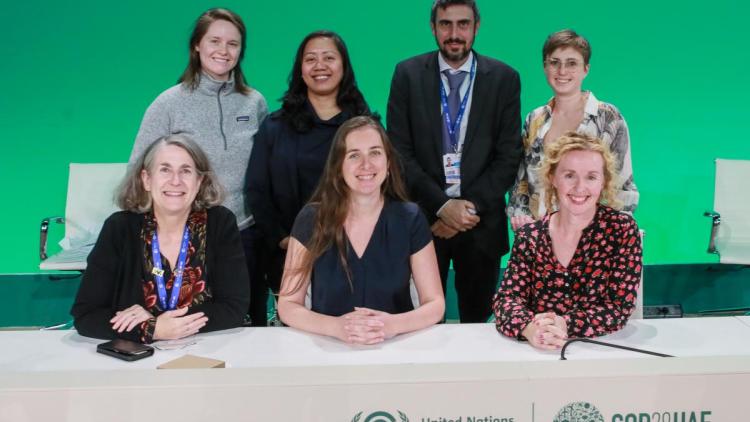
From L-R: Lynn Wagner, US; Hillary Rosentreter, Canada; Cristina Mundin, the Philippines; Jennifer Bansard, Germany; Mike Muzurakis, Greece; Anna Dubrova, Ukraine; and Jen Allan, Canada/UK
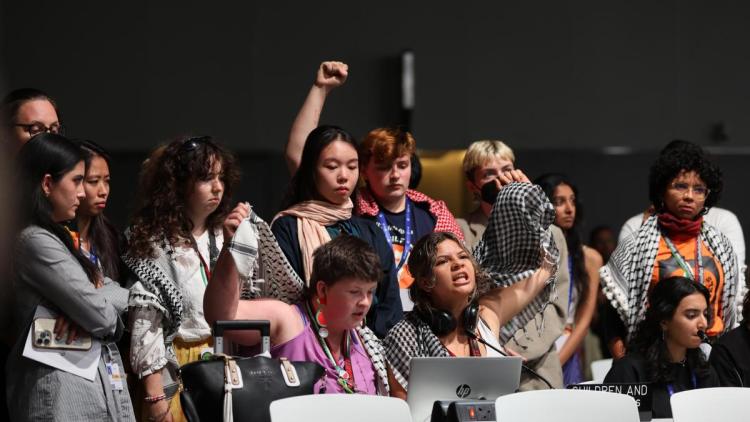
Youth delegates delivering their statement
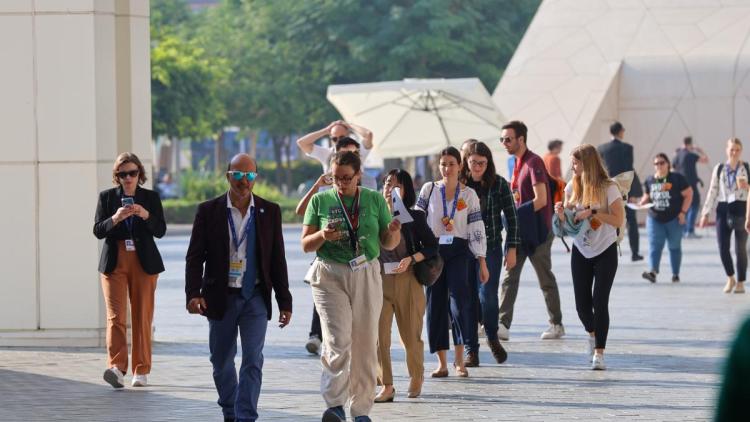
Delegates arriving for the closing plenary
While the 28th session of the Conference of the Parties (COP 28) to the UN Framework Convention on Climate Change (UNFCCC) did not finish on time, as the COP 28 President had hoped, this edition was “only” 23 hours late. For the climate negotiations, this is not a terrible score. And considering where things stood on Tuesday, 12 December, these few hours made a significant difference in securing a successful outcome.
Parties adopted a decision on the first Global Stocktake under the Paris Agreement, which recognizes the need for deep, rapid, and sustained reductions in greenhouse gas (GHG) emissions in line with 1.5°C pathways. It encourages parties to come forward in their next nationally determined contributions with ambitious, economy-wide emission reduction targets, covering all GHGs, sectors and categories and aligned with limiting global warming to 1.5°C.
Among other things, the decision also calls on parties to contribute, in a nationally determined manner, to global efforts on:
- tripling renewable energy capacity globally and doubling the global average annual rate of energy efficiency improvements by 2030;
- accelerating efforts towards the phase down of unabated coal power;
- accelerating efforts globally towards net zero emission energy systems, utilizing zero- and low-carbon fuels well before or by around mid-century;
- transitioning away from fossil fuels in energy systems, in a just, orderly, and equitable manner, accelerating action in this critical decade, so as to achieve net zero by 2050 in keeping with the science;
- accelerating zero- and low-emission technologies, including, inter alia, renewables, nuclear, abatement and removal technologies such as carbon capture and utilization and storage, particularly in hard-to-abate sectors, and low-carbon hydrogen production;
- accelerating and substantially reducing non-carbon-dioxide emissions globally, including in particular methane emissions by 2030;
- accelerating the reduction of emissions from road transport on a range of pathways, including through development of infrastructure and rapid deployment of zero and low-emission vehicles; and
- phasing out inefficient fossil fuel subsidies that do not address energy poverty or just transitions, as soon as possible.
Closing statements showcased how difficult it was to reach this compromise. Many denounced the lack of a clear reference to fossil fuel phase out, weak language on coal and methane, and the risks associated with so-called transitional fuels, which the decision says “can play a role in facilitating the energy transition while ensuring energy security.” Others found the reference to these specific global efforts too prescriptive and underscored the bottom-up and nationally-determined nature of the Paris Agreement.
Parties also adopted the framework for the Global Goal on Adaptation, launched the implementation of the work programme on just transition pathways, and adopted a number of other decisions.
President Al Jaber welcomed the outcome as a “victory for multilateralism” and a sign of solidarity and collaboration. He called the meeting a “historic turning point” that puts 1.5°C back in reach and gavelled COP 28 to a close at 5:11 pm.
To dig deeper into the discussions at COP 28, read the full Earth Negotiations Bulletin daily report.
Our Insights

We Are on Course for a Very Dangerous Amount of Warming—But There Is Still Time to Change Course
Q&A with Greg Muttitt, Senior Associate at the International Institute For Sustainable Development and a lead author of the United Nations Environment Programme’s Emissions Gap Report 2023.
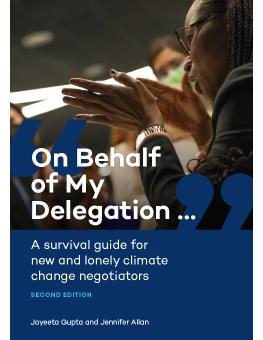
On Behalf of My Delegation (Second Edition)
This backpacker’s guide to the world of climate change negotiations sums up key challenges faced by negotiators and ways to overcome these problems.
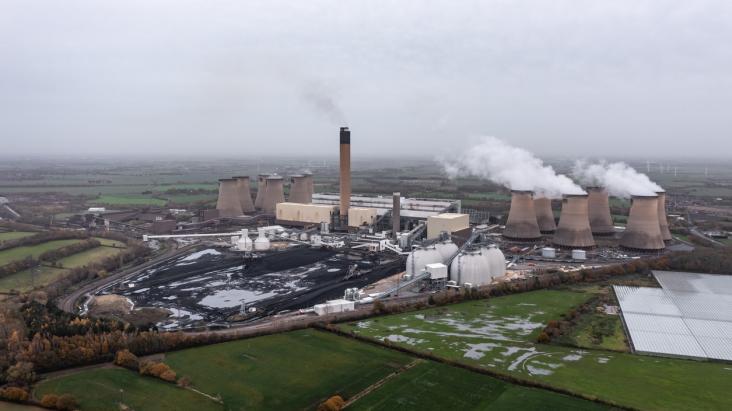
Unpacking Carbon Capture and Storage: The technology behind the promise
Many fossil fuel-producing countries are placing big bets on carbon capture and storage to cut emissions. This article takes a closer look at the feasibility, costs, and risks associated with carbon capture and storage to shine a light on why it doesn't live up to its reputation as a definitive solution.

How the UNFCCC Can Tackle Fossil Fuel Subsidies at COP 28 and Beyond
COP28 could be a turning point for action on fossil fuel subsidies—if there is political will. How have fossil fuel subsidies featured in UNFCCC negotiations so far? And how can action on fossil fuel subsidies be taken at COP 28 and beyond?

Four Key Elements to Ensure a Successful Global Goal on Adaptation
As the final rounds of negotiations on the GGA kick off at COP 28, a looming question remains: Will it be comprehensive enough for countries to implement in the years ahead?

The Global Stocktake Needs to Send a Strong Message on Adaptation
Concluding at COP 28, the inaugural global stocktake sheds light on our collective progress toward reaching the Paris Agreement’s goals. What signals should it send to countries to strengthen adaptation and resilience in the next 5 years?
Our COP 28 Experts

Nathalie Bernasconi-Osterwalder
Vice-President, Global Strategies and Managing Director, Europe

Anne Hammill
Associate Vice-President, Resilience

Philip Gass
Director, Energy Program, Just Transitions and Canada

Alec Crawford
Director, Nature for Resilience

Angie Dazé
Director, Gender Equality and Social Inclusion for Resilience

Lynn Wagner
Senior Director, Tracking Progress

Anna Ackermann
Policy Analyst, Green Reconstruction of Ukraine

Jennifer Allan
Writer/Editor, Earth Negotiations Bulletin

Jennifer Bansard
Writer, Earth Negotiations Bulletin

Christopher Beaton
Director, Energy Program, Public Financial Flows

Emilie Beauchamp
Lead, Monitoring, Evaluation, and Learning for Adaptation to Climate Change

Olivier Bois von Kursk
Policy Advisor

Aia Brnic
Communications Manager

Liesbeth Casier
Lead, Public Procurement and Sustainable Infrastructure and Coordinator of the NBI Global Resource Centre

Aurélie Ceinos
Senior Policy Advisor, Gender Equality and Social Inclusion
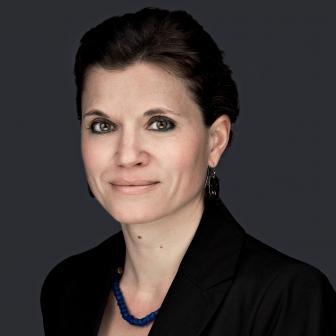
Julie Dekens
Principal Researcher

Nichole Dusyk
Senior Policy Advisor and Lead, Canada Energy

Siddharth Goel
Lead

Orville Grey
Head of Secretariat, NAP Global Network

David Hoffmann
Coordinator, NAP Global Network

Natalie Jones
Policy Advisor

Jonas Kuehl
Policy Advisor

Tara Laan
Senior Associate

Christian Ledwell
Knowledge Manager, NAP Global Network
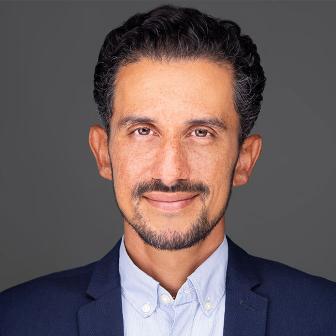
Mauricio Luna-Rodríguez
Senior Policy Advisor, Climate Change Adaptation Governance, NAP Global Network

Claire McConnell
Policy Advisor

Greg Muttitt
Senior Associate

Juliet Perry
Communications Manager

Jeffrey Qi
Policy Advisor I

Alexandra Readhead
Director, Tax and Sovereign Debt

Paulina Resich
Senior Communications Manager

Shruti Sharma
Lead

Benjamin Simmons
Director, Sustainable Infrastructure

David Uzsoki
Lead, Sustainable Finance

Farooq Ullah
Senior Policy Advisor and Lead, Energy and Climate Governance

